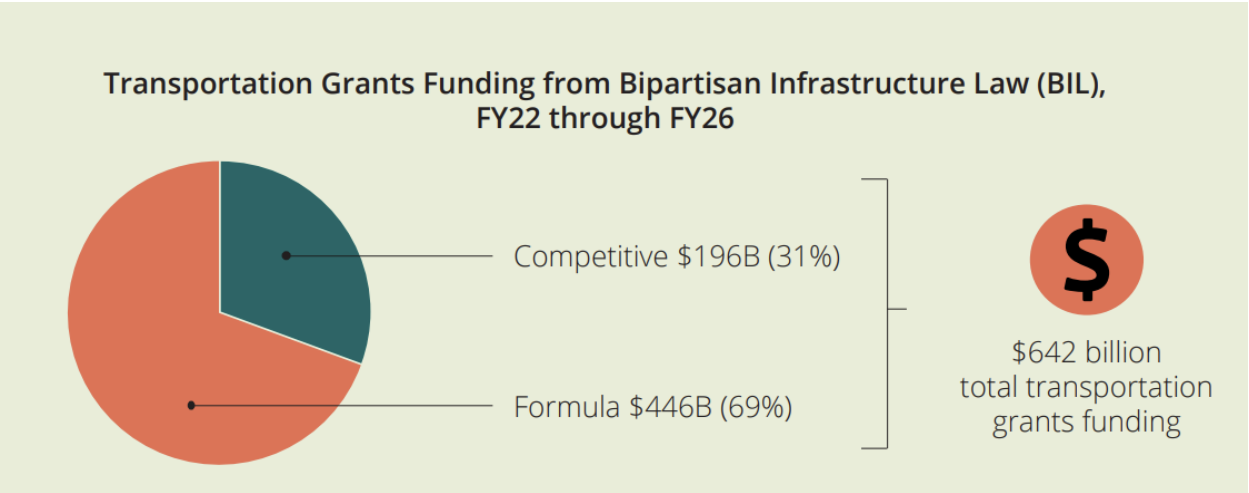May 16 marks the beginning of Infrastructure Week – the last time this week will be celebrated, thanks to the Bipartisan Infrastructure Law (BIL). America is now in a five-year sprint of federal infrastructure programs at historic levels. The Bipartisan Infrastructure Law will provide $1.2 trillion over 5 years and now is the time to make a plan in your city to maximize these investments.
Previously, Infrastructure Week was an opportunity for local and national leaders to advocate to change the dire condition of basic infrastructure assets, but now, cities, towns and villages need to take action to put the BIL to use in their communities. NLC is dedicated to preparing local governments to get ready to put this historic funding to work in their communities, which is why we want to level-set with some of the most common questions:
- What’s in the Bipartisan Infrastructure Law for cities?
- How can local governments receive funds?
- What federal programs can my city directly apply to?
- How can I start infrastructure conversations at home?
- Where can I find more infrastructure resources?
What’s in the Bipartisan Infrastructure Law for Cities?
Every dollar in the $1.2 trillion Bipartisan Infrastructure Law has a purpose and a path. Congress wrote into the law’s programs the eligible uses, eligible recipients, and how funds will be delivered to them. Infrastructure covers a lot, but there are 12 basic categories in the BIL:
- Roads, Bridges, and Major Projects
- Road Safety
- Passenger and Freight Rail
- Public Transportation
- Airports
- Ports and Waterways
- Electric Vehicles, Buses, and Ferries
- Clean Energy and Power
- Water
- Resilience
- Environmental Remediation
- Broadband and Cybersecurity

This chart demonstrates a visual representation of the main categories in BIL and their allocated funding amounts.
Taking the big picture on the top three investments from BIL, more than half of the BIL is transportation. The second-largest trend of funding is climate, energy, and environment-related (approximately $209B), and the third-largest priority area is broadband ($64B).
How Can Local Governments Receive Funds?
Cities, towns and villages are ready to rebuild their infrastructure with these new federal programs and resources included in BIL, but how do the funds get to your city?
- Your state via the Governor and various state departments
- Directly to your city from the federal government
- Your metropolitan planning organization (MPO) or regional council
- Infrastructure authorities such as transit, airports or port authorities
Traditionally, Congress sends most federal grants to the states with specific guidance for how those funds can be used or passed along to local governments. However, Congress now recognizes that regional and local organizations are effective at reaching communities’ needs more expeditiously, and the BIL uses a more balanced approach by opening competitive programs that communities can access directly at the federal level.
There are two different methods for local governments to receive the funding included in BIL:

Follow the infrastructure funds distributed to each state, MPO or infrastructure authority. Local governments will need to work with their state partners to receive funding for many of their project proposals (especially for water, energy and broadband), and the White House has requested each state identify a coordinator and reach out to local governments as they make their plans. However, there is no substitute for working with your State Municipal League and being sure to follow your state’s process to insert your priorities into their planning.

Apply for federal funds directly on your own or with eligible partners as a team. “Subdivisions of a state” is the legislative term referring to a city, town or village (as well as county), and many of the federal programs make cities, MPOs, counties, and tribes directly eligible for competitive grants that will be available from the reserved funding for the federal government to distribute. Groups of eligible applicants are not only allowed but encouraged in most programs which may allow for better use of engineering or planning resources.
What Federal Programs can My City Directly Apply To?
The BIL refunded many existing programs that cities use, but perhaps more importantly it started many new programs that cities are eligible to access. For example, 31% of the $642 billion in total transportation grants are competitive which is a huge improvement in federal program access for cities, towns, and villages to these programs. Here is a sample of some of the top programs to consider working on:

Source: U.S. Department of Transportation
Transportation
- The Safe Streets and Roads for All grant program. Provides $5 billion in direct support to local governments for safety planning and implementation projects on roads that make them safer. This program is providing pre-application support now and will be opening soon in May. Today, most cities have eligible plans and projects that they can leverage this program for.
- Rebuilding American Infrastructure Sustainably and Equitably Grants (RAISE), also referred to as the Local and Regional Project Assistance Program. This program was open for applications through mid-April and has an allotment of approximately $7.5 billion to provide grantees. Under the transportation category, this is the broadest available funding that can be distributed directly to a community.
- Promoting Resilient Operations for Transformative, Efficient, and Cost-saving Transportation Program (PROTECT). This program aims to build community resilience in the face of extreme weather and natural disasters and cities, towns, and villages have the opportunity to apply for $1.4 billion dollars of the program’s total funding through competitive grants. Check out a recent NLC blog explaining more about this opportunity here.
Broadband
- Digital Equity Competitive Grant Program. This program is funded at $1.25 billion and aims to support the implementation of digital equity projects. Local governments can apply for this competitive grant on their own or in partnership with another entity.
- Enabling Middle Mile Broadband Infrastructure Program. This program is funded at $1 billion and will provide funding to expand and extend middle-mile infrastructure to reduce the cost of connecting unserved and underserved areas to the internet backbone. Local governments can apply for this competitive grant on their own or in partnership with another entity.
Environment, Energy
- Brownfields Revitalization. BIL provides $1.5 billion for the EPA Brownfields program to scale up community-led brownfields revitalization. This additional funding will help put blighted and polluted sites in communities across the country back into productive reuse, spurring job creation and economic opportunity.
- Energy Efficiency and Conservation Block Grant. With the $550 million provided through BIL, cities, towns and villages can develop comprehensive energy plans and jump-start or enhance energy efficiency programs in their communities. This program is available directly as formula grants from the U.S. Department of Energy to cities over 35,000 in population or the top 10 most populous cities in the state. Learn more here.
How Can I Start Infrastructure Conversations at Home?
Talk With Your State
Your state is a critical infrastructure partner, and they are officially moving programs forward that your city can utilize. Here are a sample of some of the top programs to begin working with your state on:
- National Electric Vehicle Infrastructure (NEVI) Formula Program. This program provides the states $5 billion to focus on electric vehicle corridor charging around the nation’s major road networks and alternative fuel corridors. To secure funding from this pool of money, municipalities will need to work directly with their respective state DOT offices. In addition, August 1, 2022, is the deadline for states to submit their EV infrastructure deployment plans to the Joint Office of Energy and Transportation, and interested local governments should be talking with their state before then.
- Carbon Reduction Program. This program has a total funding amount of $5 billion and aims to fund projects that look to reduce transportation emissions from on-road highway sources. This program’s fund distribution will be appropriated to each State as a lump sum and then divided among the apportioned programs. The sub-allocation from each state will be split up by urban size and population.
- Broadband, Equity, Access, and Deployment (BEAD) Program. This program provides approximately $42 billion to states to utilize for broadband deployment, mapping, and adoption projects. Local governments can apply to their state for subgrants in accordance with their state broadband plans, which will begin to develop this year. The funding will likely not start until 2023.
- Clean Water State Revolving Fund Program (CWSRF). This established program provides communities with low-cost financing for a wide range of water quality infrastructure projects. BIL provides $11.713 billion in new funding for the traditional SRFprogram and $1 billion to address per-and polyfluoroalkyl substances (PFAS) or other emerging contaminants in wastewater. Local governments can apply to their state for funding under this program and a list of state contacts for the CWSRF program can be found on this webpage.
- Drinking Water State Revolving Fund Program. This is another established financial assistance program to help water systems and states achieve the health protection objectives of the Safe Drinking Water Act. BIL provides $11.713 billion for the traditional SRF program, $15 billion for efforts related to lead pipe removal, and $4 billion to address PFAS drinking water contamination. Local governments can apply for funding to their state and find a list of contracts and state websites on this webpage.
Share Your Project
Does your city have a great project in the works that you’re seeking federal funding for? The National League of Cities (NLC) and Polco have partnered together to create this survey to show how local communities are planning infrastructure projects that could use the $1.2 trillion in Bipartisan Infrastructure Law (BIL) investment in roads, transit, water, broadband and more. Share your infrastructure needs and projects here.
Where Can I Find More Infrastructure Resources?
- Ready to Rebuild: Infrastructure Webinar Series
- White House www.build.gov Infrastructure Program Guidebook
- White House “Infrastructure School” Webinars
- NLC Infrastructure Insights Dashboard
Show Your Infrastructure Support
Check out the NLC Infrastructure Week toolkit for examples of how your community can celebrate Infrastructure Week, such as:
- Sending a press release,
- Holding a press event,
- Posting on social media,
- Issuing a proclamation.
Join an NLC event:
- Implementing the Bipartisan Infrastructure Law at FEMA – Watch live on Monday, 5/16, starting at 11AM ET.
- Infrastructure Week Kickoff – Watch live on Monday, 5/16, starting at 1PM ET.
- USDOT – Getting Ready for the Reconnecting Communities Pilot Discretionary Grant Program – Register here for the May 19 webinar from 1:30pm – 2:30pm EDT.












